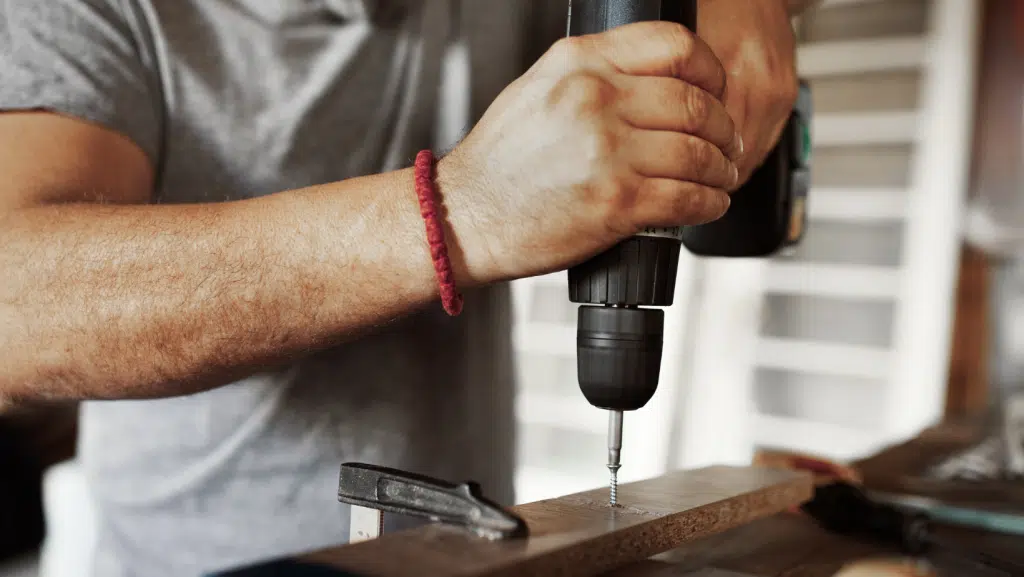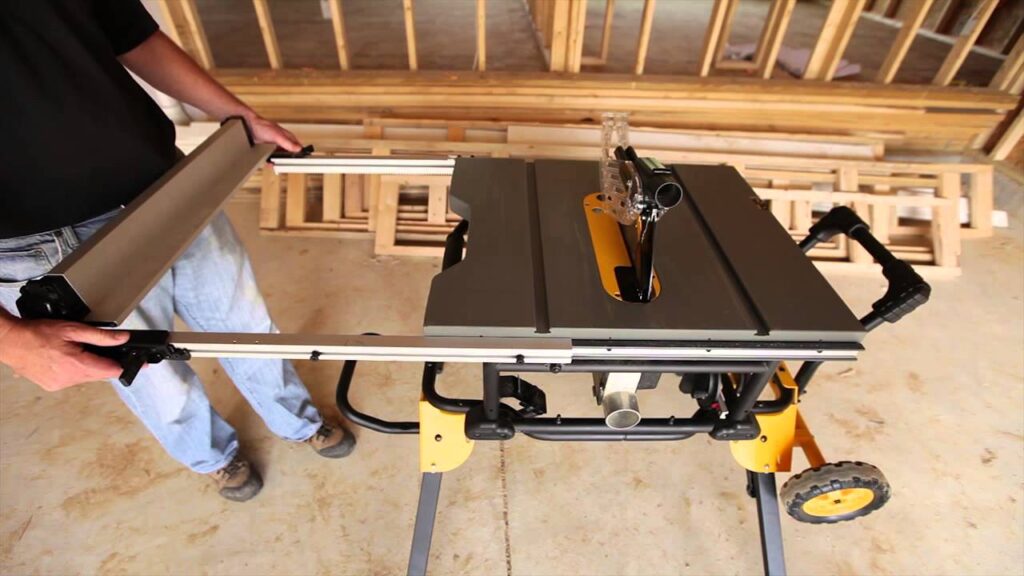The humble portable table saw has become a common fixture in both professional workshops and home setups, and its popularity shows no signs of declining in the near future.
With market predictions indicating that the global demand for table saws will continue to surge throughout the 2020s, many woodworkers may be curious about how to set up a portable table saw.
Several table saws come with a built-in platform that assists in supporting your workpiece and ensuring clean cuts. Larger models may include a foldable workbench connected to the table saw.
On the other hand, standalone models of portable table saws require manual mounting for safe and effective use. If you’ve found your way here, you’re likely seeking guidance on how to mount a portable table saw.
Therefore, we present our top two methods for mounting your portable table saw.
Create a Stand for Your Portable Table Saw:

Select the Right Wood:
The key advice for ensuring that you build the finest stand for your portable table saw is to make certain you pick the correct wood. Whether you’re crafting a basic saw stand or something a bit more elaborate, subpar wood will inevitably result in a less resilient workstation.
In truth, the best woods available are often the pricier options, and this expense often proves to be a wise investment. When you use high-quality wood, your table saw stand can endure for a lifetime.
Our recommendation for this project is to go for high-quality oak. Opt for good oak boards sized at 2 inches by 8 inches by 8 feet; these should be perfect. Additionally, it’s important to source quality lumber for the table’s support and the legs, as these components need to be robust, stable, and long-lasting.
Stationary or Static:
When you’re contemplating how to construct a workstation for your portable table saw, one crucial decision is whether you want it to be stationary or mobile.
A stationary workstation is firmly attached to your portable table saw, offering a permanent storage space for your tools. This is a good choice if you consistently work in the same location, like a home workshop.
However, a fixed workstation lacks flexibility and isn’t easy to relocate. If you want to maintain the portability of your table saw, consider a mobile workstation.
As the name implies, a portable workstation enables quick packing and isn’t permanently affixed to the table. It’s compact, lightweight, and constructed without fasteners.
Deciding between a stationary and portable workstation is a vital initial step. The type of workstation you choose will guide the measurements and design of your workstation as you proceed with the project.
Determine Your Workstation’s Dimensions:
It’s time to take some measurements, and this step is absolutely vital! Making precise and careful measurements is essential because it ensures that your portable table saw stand will fit nicely into your working area, accommodate your table saw, and look great.
When you’re measuring, always take into account the materials you’ve chosen. Consider the space you have available and the style you want for your workstation.
Keep in mind that if you opt for a larger table saw stand, it will become a more substantial project, requiring extra materials and more time.
However, the advantage is that it will provide you with more workspace and storage for your tools.
Construct the Frame for the Portable Table Saw:
Now it’s time to construct the frame using your 2×2 lumber.
Remember to stick to your design and the measurements you’ve taken. Think about how many shelves and cabinets you want to incorporate into your workstation.
At this point, decide if you’re building a stationary or a mobile workstation.
Based on your measurements, use a jigsaw to cut the lumber to the required sizes. It’s often simpler to start building the frame from the workstation’s base and work your way up.
For the legs, opt for sturdier and thicker lumber, such as 2×4 inches. This ensures the legs can bear the workstation’s weight without cracking or structural issues.
Measure the base from your cut and connect it with the four legs. Use wood glue and either a hammer or a nail gun to secure the pieces together. The legs can be the same length as the base frame or longer, depending on your design.
If you plan to add rollers at the bottom, ensure the legs are level with the base frame.
Starting from the base frame, add the cabinet frame following your design. Finish by installing the top frame, which should be wider than the table saw surface to create additional workspace.
The frame should have an opening that accommodates the table saw, typically at the workstation’s center.
Consider Paneling and Supplementary Elements:
You should now have a sturdy skeletal structure for your table saw stand, assembled with nails and glue to ensure it’s strong and steady. It’s time to use plywood sheets to cover this frame.
To start, measure and cut the two side panels. Use nails and a hammer to securely attach the plywood to the frame. Depending on your design choices, you can also consider covering the front and back of the frame.
At this stage, you can decide whether to incorporate shelves or drawers into your workstation. Making drawers can be a bit more intricate, while shelving is a simpler option, particularly for beginners.
Once you’ve added any desired drawers or shelving, cut the tabletop from a durable wooden board, making sure to leave an opening for your portable table saw.
Attach the tabletop to the frame using nails, along with either a nail gun or a hammer.
Inserting the Table Saw:
Now it’s time for the decisive moment – integrating your portable table saw into the workbench tabletop you’ve constructed.
Keep in mind that portable table saws can be quite weighty, so exercise caution when lifting the saw and gently placing it into the designated space on the tabletop. If you’ve followed our instructions, your portable table saw stand should be sturdy enough to support the saw securely.
End procedures, Wrapping up:
Your task isn’t quite finished yet. You’ve put in a lot of effort into this project, and you want it to look its absolute best.
Grab some sandpaper and use it to gently smooth out any rough spots, ensuring a consistent and clean appearance in your workspace. We’ve found that 150-grit sandpaper works best for this job.
Next, apply a coat of polyurethane to the tabletop. This helps to shield it from unsightly scratches and minimizes the wood’s ability to soak up water, which could otherwise cause warping and distortion.
The good news is that the polyurethane finish won’t alter the classic wooden appearance of your workbench, so you can still enjoy that timeless wooden look.
Purchase a Table Saw That’s Already Mounted:

If the idea of constructing an entire workstation or crafting your DIY base doesn’t appeal to you, why not consider purchasing a pre-mounted portable table saw?
With a wide array of outstanding table saws available on the market, it’s never been easier to find a portable table saw that fulfills all your requirements.
An excellent example of a top-notch table saw with an integrated workstation is the SAWSTOP 10-Inch Professional Cabinet Saw.
The 36-inch T-Glide Fence & Rail are constructed from heavy-gauge steel, ensuring a secure lockdown and consistently precise cuts for many years without any deviation.
The Sawstop patented safety system swiftly halts a spinning blade upon contact with skin. The blade comes to a halt in under five milliseconds and retreats beneath the table, reducing what could have been a life-altering injury to a minor scratch.
The trunnion and arbor are engineered for precision, durability, and stability. The gas piston elevation provides effortless and smooth adjustability.
This saw not only boasts exceptional features but also offers 99% dust collection above the table with the included dust collection blade guard. Moreover, there’s additional dust collection below the table thanks to advanced shrouding around the blade.
And don’t forget the pre-mounted workstation, which takes care of the task of setting up a portable table saw for you.
Bottom Line: How to Mount a Portable Table Saw
By following these uncomplicated guidelines on how to set up a portable table saw, you can maximize your use of it, whether you’re a seasoned professional or a novice. However, it’s essential to adhere to the guidelines provided by the manufacturer. When in doubt, always consult the instructions!
FAQs: about How to Mount a Portable Table Saw
What is a Portable Table Saw?
A portable table saw is a valuable tool. It can be easily moved to wherever work is happening, whether it’s indoors or outdoors, helping to contain dust and noise in outdoor settings. Most of these saws come with a 10-inch blade, offering ample clearance above the table for cutting thick lumber.
What Precautions Should You Take When Using a Table Saw?
Avoid stretching over the saw to grab things from the opposite side. When turning off the power, refrain from trying to halt the saw abruptly by pushing objects against the blade. Wait until the saw has completely stopped before moving away from it. Do not make any alterations to the saw while it is in operation.
Is the Size of a Table Saw Important?
When selecting a table saw, it’s crucial to examine the rip capacity. It’s recommended to have a capacity exceeding 24 inches because it equals half the width of sheet material. Certain saws provide a generous rip capacity of 35 inches. Larger table saws deliver superior capacity.
Related Posts:
